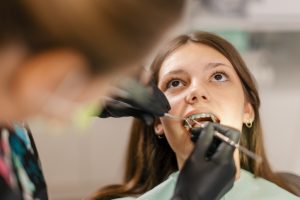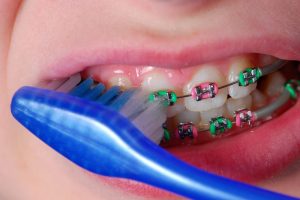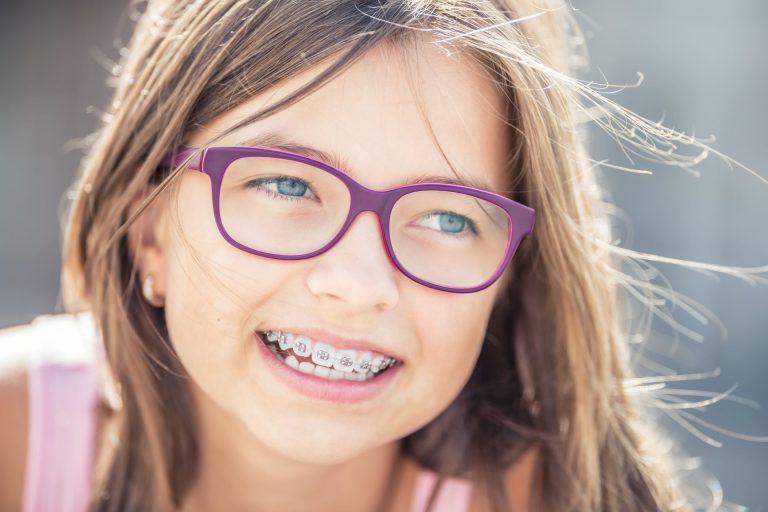As parents, many of us have hang-ups about braces, with the terms “metal-mouth,” “railroad tracks” and “headgear” echoing in our teen memories.
However, if your child needs braces, you’ll be glad to hear that they’re extremely common now. So, if your kids are getting braces; here are some essential tips for parents to help you and your child navigate this new orthodontic experience.

Easing your child’s worries about getting braces
As with anything new, your child may feel stressed about getting braces. They may be concerned that they will look different and not fit in with their peers. The good news is: if you look around any middle school, junior high, or high school, you’ll see kids with braces everywhere. Your child is not alone – in fact, they’re joining a large group of classmates who already have braces.
Encourage your child to talk to siblings, peers or cousins who have braces (or who previously had them) to get their comments. When I asked my 17-year-old son what he remembered about his time with braces, he shrugged and said, “barely anything.” Clearly, he wasn’t scarred for life by the experience.
As you try to reassure your child, don’t expect to have much success with ‘big picture’ statements like “your teeth will look so nice when it’s over” or “it’s only two years.” Tweens and teens live in the moment and can’t necessarily grasp the long-term benefits. To them, two years may as well be 200 years. Instead, show empathy and try to help them through whatever stage of the process they’re in right now.
Tips for the early days of braces
Realistically, the initial orthodontist appointments — involving steps such as taking molds/impressions, installing brackets and attaching/tightening wires — won’t be super enjoyable for your child. One perk is that they may have the option to personalize their braces in a color of their choice.
Afterwards, to give your child a pick-me-up, be ready with a little non-food gift you know they’ll like, such as:
- A new case for their mobile device
- Hair products or accessories
- Lip balm
- A magazine, book or comic book
- A package of collectible cards
- A keychain or backpack charm
- Colorful pens, pencils or other art supplies
- A small gift card to a favorite store that relates to their interests (such as crafts, sports, music or gaming)
My 15-year-old niece got braces this year and described the initial feeling as “weird and a bit uncomfortable.” She said that the braces themselves weren’t painful, but the action of chewing was difficult for the first week. Your orthodontist may recommend an over-the-counter medication like Tylenol or Advil to ease any minor pain.
Foods your child should eat (and not eat) with braces
First and foremost, be sure to follow the instructions provided by your orthodontist’s office. They may give you written information or refer you to a website for further details.
In the early days of braces, your child will do best with liquids or soft foods that don’t require much chewing. Some typical go-to choices are milkshakes, smoothies, soup, yogurt, applesauce, ice cream, pudding, Jell-O, mashed potatoes and scrambled eggs. Adjust your menu based on your child’s tolerance.
To avoid damaging their braces, your child should consistently avoid foods that are hard, chewy or sticky, such as:
- Hard candies and lollipops
- Chewy candies like gummies, taffy and caramels
- Nuts and seeds
- Chips and pretzels
- Gum
- Popcorn
A quick side note about Halloween: you may notice that many of the items on the list above are candy-related. When October rolls around, you may need to get creative with different “treats” that are braces-friendly, such as specialty ice cream or home-baked desserts like cookies, cake or brownies.
For some foods, you’ll need to modify how they are prepared and served. For example, rather than your child biting into an apple with their front teeth, cut it up into bite-sized pieces to make it a finger food. Similarly, a hamburger patty can be cut into pieces to eat with a fork, with the toasted bun cut into bite-sized pieces on the side.
How to keep braces clean

Again, follow the care and maintenance instructions provided by your orthodontist. By far, my number one braces cleaning tip is to invest in a water flosser. This easy-to-use handheld device sprays a thin stream of water that is very effective to loosen food from braces before brushing with a regular toothbrush.
If the brackets or wires are causing the inside of your child’s mouth to become sore, look for orthodontic wax at your local pharmacy. Have your child squish the wax between their fingers and press it onto the wire ends or brackets that are bothersome.
Create a “braces care kit” for your kid
Consider creating a portable “braces care kit” for your child to take to school or sleepovers. Fill a zippered toiletry bag (or pencil case) with a toothbrush, travel-sized toothpaste, flosser picks, extra elastics, and lip balm.
If your child plays sports, you’ll want to protect your investment with a mouthguard designed specifically to fit over braces. Be sure to label the case to avoid mix-ups (Mabel’s Labels Small Rectangular Labels are perfectly sized for this purpose).
Getting braces may feel like a big deal at first, but there’s no need to “brace yourself” for the worst. Stay positive in the early going and be patient as your child adjusts to the tweaks in their eating and brushing routine. They will adapt – probably sooner than you expect. Good luck!

